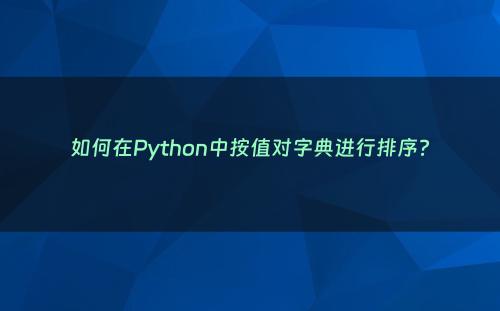网站首页 > 基础教程 正文
大家在使用Python处理数据时,经常会用到字典这种数据结构。有时候,我们需要对字典按值进行排序,这该怎么做呢?今天咱们就来详细探讨一下这个问题。
字典排序的基础认知
在Python里,字典本身是没有顺序的,也就是说,我们没办法直接对字典进行排序。不过,我们可以借助其他有序的数据类型,像列表、元组来呈现排序后的结果。

不同Python版本的排序方法
Python 3.7+ 或 CPython 3.6
在Python 3.7及以上版本,以及CPython 3.6版本中,字典会保留插入顺序。我们可以使用以下方法按值对字典进行排序:
x = {1: 2, 3: 4, 4: 3, 2: 1, 0: 0}
# 方法一
sorted_dict = {k: v for k, v in sorted(x.items(), key=lambda item: item[1])}
print(sorted_dict)
# 方法二
sorted_dict_2 = dict(sorted(x.items(), key=lambda item: item[1]))
print(sorted_dict_2)旧版本Python
对于旧版本的Python,我们只能得到字典排序后的表示形式。可以使用以下方法:
import operator
x = {1: 2, 3: 4, 4: 3, 2: 1, 0: 0}
# 按值排序
sorted_x = sorted(x.items(), key=operator.itemgetter(1))
print(sorted_x)
# 若想按键排序
sorted_x_by_key = sorted(x.items(), key=operator.itemgetter(0))
print(sorted_x_by_key)在Python 3中,由于不允许拆包,我们可以使用lambda函数:
x = {1: 2, 3: 4, 4: 3, 2: 1, 0: 0}
sorted_x = sorted(x.items(), key=lambda kv: kv[1])
print(sorted_x)如果希望输出结果是字典形式,可以使用collections.OrderedDict:
import collections
sorted_dict = collections.OrderedDict(sorted_x)
print(sorted_dict)其他实用的排序方法
简单排序法
dict1 = {'one':1,'three':3,'five':5,'two':2,'four':4}
sorted_keys = sorted(dict1, key=dict1.get)
for key in sorted_keys:
print(key, dict1[key])lambda函数排序法
d = {'one':1,'three':3,'five':5,'two':2,'four':4}
# 升序排序
a = sorted(d.items(), key=lambda x: x[1])
print(a)
# 降序排序
b = sorted(d.items(), key=lambda x: x[1], reverse=True)
print(b)使用collections.Counter排序
如果字典的值是数值类型,我们可以使用collections.Counter:
from collections import Counter
x = {'hello': 1, 'python': 5, 'world': 3}
c = Counter(x)
print(c.most_common())总结
在Python中按值对字典进行排序有多种方法,大家可以根据自己使用的Python版本以及具体需求来选择合适的方法。希望今天的内容能帮助大家更好地处理字典排序问题!
- 上一篇: Python哈希表:了解哈希函数与字典
- 下一篇: 探索 Python 中字典推导式的艺术性
猜你喜欢
- 2025-05-02 Python代码使用字典推导式(python的字典怎么用)
- 2025-05-02 失业程序员复习python笔记——字典和集合(2)
- 2025-05-02 Python中删除字典元素的方法(python 字典 删除)
- 2025-05-02 探索 Python 中字典推导式的艺术性
- 2025-05-02 Python哈希表:了解哈希函数与字典
- 2025-05-02 失业程序员复习python笔记---字典和集合(1)
- 2025-05-02 Python 字典合并、求和大作战,轻松搞定各路数据
- 2025-05-02 Python 访问字典视图 #python爬虫
- 2025-05-02 python学习——025python遍历字典四种方法
- 2025-05-02 一文掌握Python 字典遍历的8种方法
- 最近发表
- 标签列表
-
- jsp (69)
- gitpush (78)
- gitreset (66)
- python字典 (67)
- dockercp (63)
- gitclone命令 (63)
- dockersave (62)
- linux命令大全 (65)
- pythonif (86)
- location.href (69)
- dockerexec (65)
- tail-f (79)
- queryselectorall (63)
- location.search (79)
- bootstrap教程 (74)
- deletesql (62)
- linuxgzip (68)
- 字符串连接 (73)
- html标签 (69)
- c++初始化列表 (64)
- mysqlinnodbmyisam区别 (63)
- arraylistadd (66)
- mysqldatesub函数 (63)
- window10java环境变量设置 (66)
- c++虚函数和纯虚函数的区别 (66)
